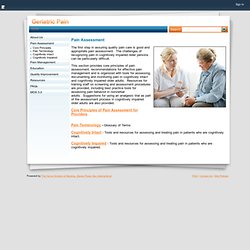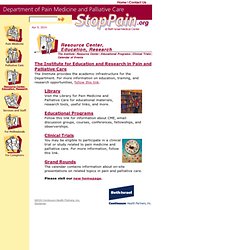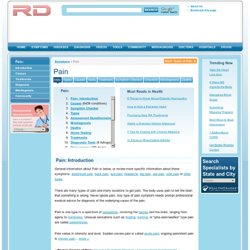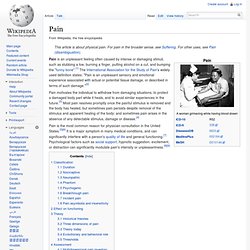

Pain Assessment. Pain Assessment The first step in assuring quality pain care is good and appropriate pain assessment.

The challenges of recognizing pain in cognitively impaired older persons can be particularly difficult. This section provides core principles of pain assessment, recommendations for effective pain management and is organized with tools for assessing, documenting and monitoring pain in cognitively intact and cognitively impaired older adults. Resources for training staff on screening and assessment procedures are provided, including best practice tools for assessing pain behavior in nonverbal adults. Suggestions for using an analgesic trial as part of the assessment process in cognitively impaired older adults are also provided. Pain Management Medical Education Programs. Improving chronic pain management through treatment and education. PATIENT MANAGEMENT TOOL KIT OPIOID ANALGESIA.
Pain Management Medical Education Programs. Managing Pain – Chronic Pain Management Information for Patients & Caregivers. Pain Medicine & Palliative Care. Library Visit the Library for Pain Medicine and Palliative Care for educational materials, research tools, useful links, and more.

Educational Programs Follow this link for information about CME, email discussion groups, courses, conferences, fellowships, and observerships. Clinical Trials You may be eligible to participate in a clinical trial or study related to pain medicine and palliative care. For more information, follow this link.
Grand Rounds The calendar contains information about on-site presentations on related topics in pain and palliative care. Please visit our new homepage. Links. The Pain Web : the site for professional researching in, assessing and treating pain. Pain Concern. International Association for the Study of Pain. World Congress on Pain IASP will issue a call for poster abstracts in January 2014. View poster abstract submission guidelines.
Financial aid applications will open in January 2014. Financial aid to attend the congress is available to IASP members from developing countries, countries with currency exchange restrictions, or trainee members in developed countries. View financial aid application guidelines. Grants and Fellowships Apply Now: IASP Early Career Research Grants IASP invites eligible members to submit applications for IASP Early Career Research Grants. View the announcement Tanzanian, Nigerian Doctors Earn South African Clinical Training Fellowships For the second consecutive year, IASP supported a clinical training fellowship for developing countries in Africa with the South African Clinical Training Fellowship in Pain Management. View the winners 12th IASP Research Symposium March 21-23, 2014, Aarhus, Denmark.
IASP Publications. The Pain Web : the site for professional researching in, assessing and treating pain. A History of Pain Management. Press Releases. Pain. There are many types of pain and many locations to get pain.

The body uses pain to tell the brain that something is wrong. Never ignore pain. Any type of pain symptom needs prompt professional medical advice for diagnosis of the underlying cause of the pain. Pain is one type in a spectrum of sensations , involving the nerves and the brain, ranging from agony to numbness . Unusual sensations such as tingling , burning , or "pins-and-needles" type pain are called paresthesias . Pain varies in intensity and level. The following medical conditions are some of the possible causes of Pain. Listed below are some combinations of symptoms associated with Pain, as listed in our database. Health: Medicine: Medical Specialties: Pain Management: Organizations. StopPain.org, Department of Pain Medicine & Palliative Care. Pain Research Center University of Utah. Pain Relief Foundation: research and education of causes and relief of chronic pain. Pain.com. Health: Senses: Touch and Sensation: Pain. Pain. Pain is an unpleasant feeling often caused by intense or damaging stimuli, such as stubbing a toe, burning a finger, putting alcohol on a cut, and bumping the "funny bone".[1] The International Association for the Study of Pain's widely used definition states: "Pain is an unpleasant sensory and emotional experience associated with actual or potential tissue damage, or described in terms of such damage.

"[2] Pain motivates the individual to withdraw from damaging situations, to protect a damaged body part while it heals, and to avoid similar experiences in the future.[3] Most pain resolves promptly once the painful stimulus is removed and the body has healed, but sometimes pain persists despite removal of the stimulus and apparent healing of the body; and sometimes pain arises in the absence of any detectable stimulus, damage or disease.[4] Classification[edit] Duration[edit] Nociceptive[edit] Neuropathic[edit] Phantom[edit] Work by Vilayanur S. Psychogenic[edit] American Pain Society. American Chronic Pain Association - The ACPA – American Chronic Pain Association. StopPain.org, Department of Pain Medicine & Palliative Care.